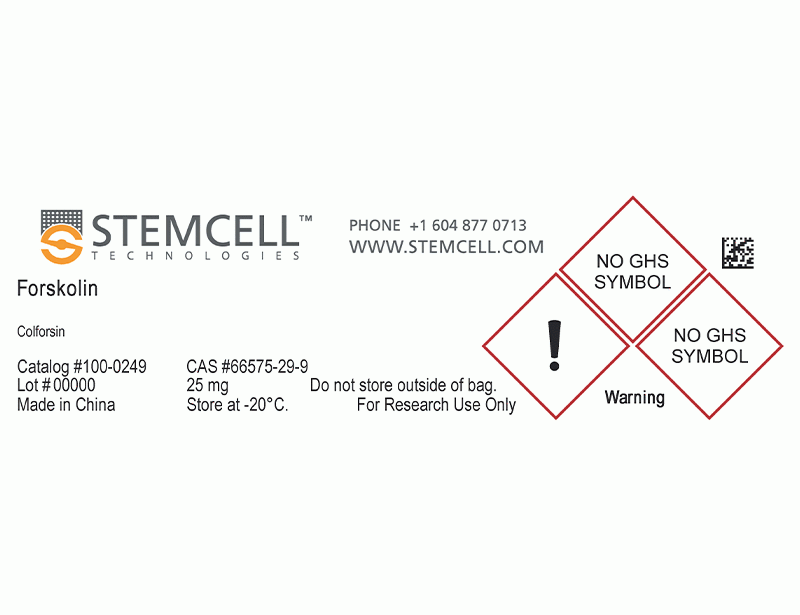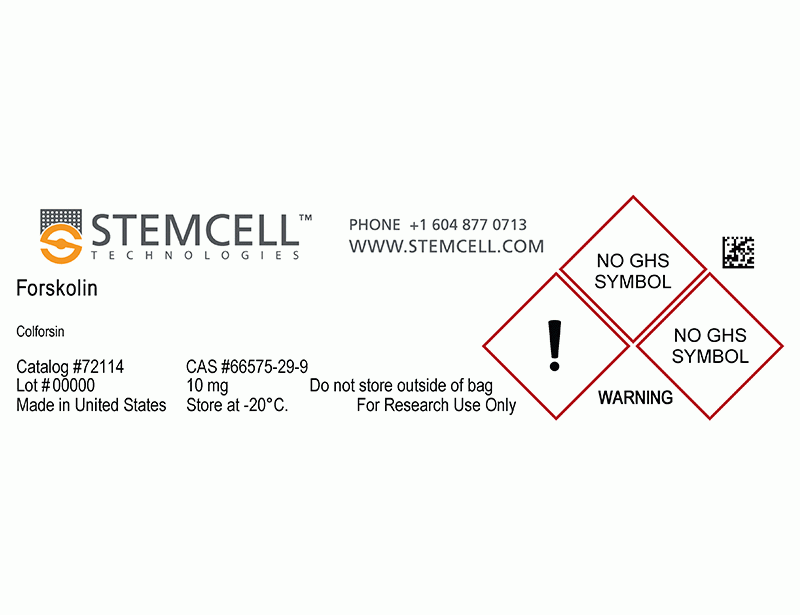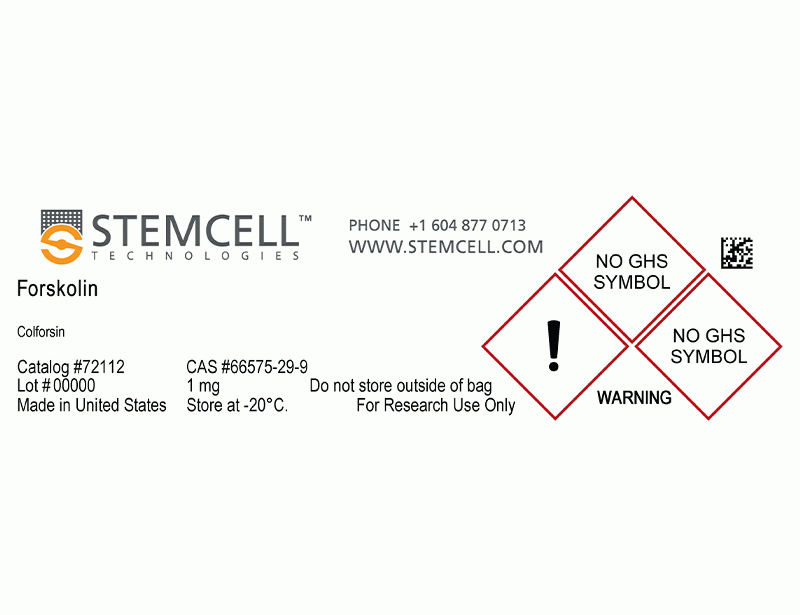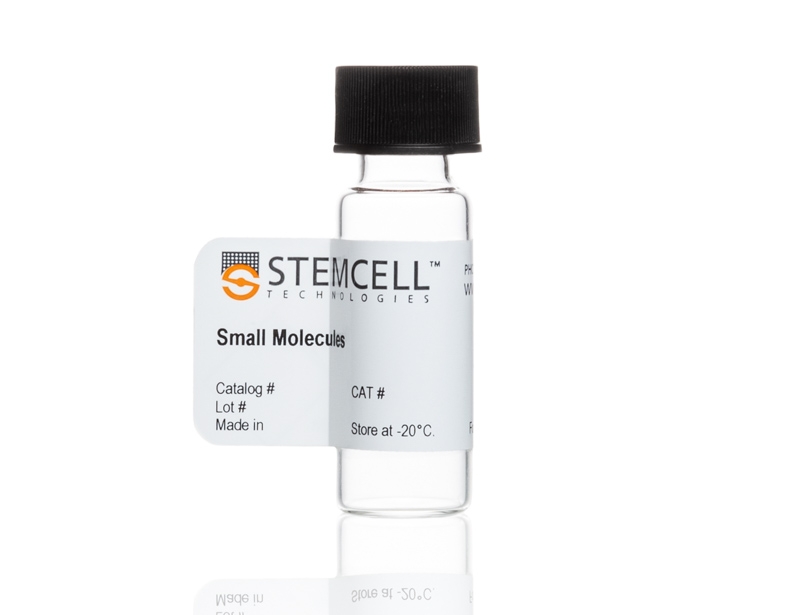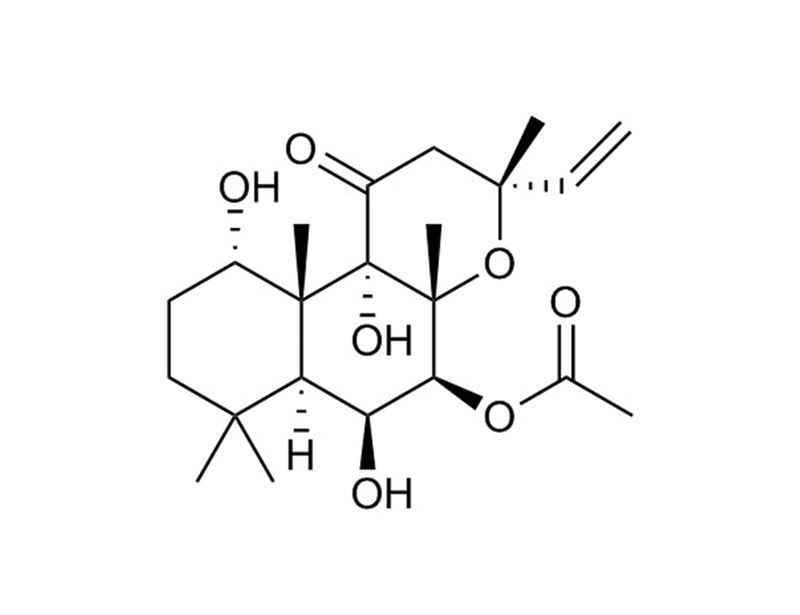Forskolin
cAMP pathway activator; Activates adenylyl cyclase
概要
Forskolin is a cell-permeable diterpene that directly activates adenylyl cyclase (IC₅₀ = 41 nM), the enzyme that produces cyclic adenosine monophosphate (cAMP), which as a result raises cAMP levels in the cell. cAMP is an important second messenger involved in many signal transduction pathways, including activation of protein kinase A (PKA; Awad et al.; Robbins et al.).
REPROGRAMMING
· Enables chemical reprogramming (without genetic factors) of mouse embryonic fibroblasts to induced pluripotent stem (iPS) cells, in combination with CHIR99021, Tranylcypromine, Valproic Acid, 3-Deazaneplanocin A, and RepSox (Hou et al.).
· Enables NGN2-mediated transdifferentiation of human fibroblasts to cholinergic neurons (Liu et al.).
· Direct lineage reprogramming of fibroblasts to mature neurons, in combination with RepSox, CHIR99021, SP600125, Valproic Acid, Gö6983 and Y-27632 (Hu et al.).
· Direct lineage reprogramming of fibroblasts to mature neurons, in combination with CHIR99021, ISX-9, SB431542, and I-BET151 (Li et al.).
· Converts human embryonic stem (ES) cells in a “naïve” or ground state similar to mouse ES cells, in combination with LIF, FGF2, TGFβ and small molecules PD0325901, CHIR99021, SP600125, and SB203580 (Hanna et al.).
DIFFERENTIATION
· Potentiates neuronal differentiation of rat hippocampal neural progenitor cells (Hsieh et al., Palmer et al.).
REPROGRAMMING
· Enables chemical reprogramming (without genetic factors) of mouse embryonic fibroblasts to induced pluripotent stem (iPS) cells, in combination with CHIR99021, Tranylcypromine, Valproic Acid, 3-Deazaneplanocin A, and RepSox (Hou et al.).
· Enables NGN2-mediated transdifferentiation of human fibroblasts to cholinergic neurons (Liu et al.).
· Direct lineage reprogramming of fibroblasts to mature neurons, in combination with RepSox, CHIR99021, SP600125, Valproic Acid, Gö6983 and Y-27632 (Hu et al.).
· Direct lineage reprogramming of fibroblasts to mature neurons, in combination with CHIR99021, ISX-9, SB431542, and I-BET151 (Li et al.).
· Converts human embryonic stem (ES) cells in a “naïve” or ground state similar to mouse ES cells, in combination with LIF, FGF2, TGFβ and small molecules PD0325901, CHIR99021, SP600125, and SB203580 (Hanna et al.).
DIFFERENTIATION
· Potentiates neuronal differentiation of rat hippocampal neural progenitor cells (Hsieh et al., Palmer et al.).
Alternative Names
Coleonol; HL 362; L 75-1362B; NSC 357088; NSC 375489
Cell Type
Neural Stem and Progenitor Cells, Neurons, Pluripotent Stem Cells
Species
Human, Mouse, Rat, Non-Human Primate, Other
Application
Maintenance, Reprogramming
Area of Interest
Neuroscience, Stem Cell Biology
CAS Number
66575-29-9
Chemical Formula
C₂₂H₃₄O₇
Molecular Weight
410.5 g/mol
Purity
≥ 98%
Pathway
cAMP
Target
Adenylyl Cyclase
技术资料
| Document Type | 产品名称 | Catalog # | Lot # | 语言 |
|---|---|---|---|---|
| Product Information Sheet | Forskolin | 72112, 72114, 100-0249 | All | English |
| Safety Data Sheet | Forskolin | 72112, 72114 | All | English |
| Safety Data Sheet | Forskolin | 100-0249 | All | English |
数据及文献
Publications (9)
Cell stem cell 2015 AUG
Small-Molecule-Driven Direct Reprogramming of Mouse Fibroblasts into Functional Neurons.
Abstract
Abstract
Recently, direct reprogramming between divergent lineages has been achieved by the introduction of regulatory transcription factors. This approach may provide alternative cell resources for drug discovery and regenerative medicine, but applications could be limited by the genetic manipulation involved. Here, we show that mouse fibroblasts can be directly converted into neuronal cells using only a cocktail of small molecules, with a yield of up to textgreater90% being TUJ1-positive after 16 days of induction. After a further maturation stage, these chemically induced neurons (CiNs) possessed neuron-specific expression patterns, generated action potentials, and formed functional synapses. Mechanistically, we found that a BET family bromodomain inhibitor, I-BET151, disrupted the fibroblast-specific program, while the neurogenesis inducer ISX9 was necessary to activate neuron-specific genes. Overall, our findings provide a proof of principle" for chemically induced direct reprogramming of somatic cell fates across germ layers without genetic manipulation�
Cell stem cell 2015 AUG
Direct Conversion of Normal and Alzheimer's Disease Human Fibroblasts into Neuronal Cells by Small Molecules.
Abstract
Abstract
Neuronal conversion from human fibroblasts can be induced by lineage-specific transcription factors; however, the introduction of ectopic genes limits the therapeutic applications of such induced neurons (iNs). Here, we report that human fibroblasts can be directly converted into neuronal cells by a chemical cocktail of seven small molecules, bypassing a neural progenitor stage. These human chemical-induced neuronal cells (hciNs) resembled hiPSC-derived neurons and human iNs (hiNs) with respect to morphology, gene expression profiles, and electrophysiological properties. This approach was further applied to generate hciNs from familial Alzheimer's disease patients. Taken together, our transgene-free and chemical-only approach for direct reprogramming of human fibroblasts into neurons provides an alternative strategy for modeling neurological diseases and for regenerative medicine.
Nature communications 2013 JAN
Small molecules enable neurogenin 2 to efficiently convert human fibroblasts into cholinergic neurons.
Abstract
Abstract
Cell fate can be reprogrammed by modifying intrinsic and extrinsic cues. Here we show that two small molecules (forskolin and dorsomorphin) enable the transcription factor Neurogenin 2 (NGN2) to convert human fetal lung fibroblasts into cholinergic neurons with high purity (textgreater90%) and efficiency (up to 99% of NGN2-expressing cells). The conversion is direct without passing through a proliferative progenitor state. These human induced cholinergic neurons (hiCN) show mature electrophysiological properties and exhibit motor neuron-like features, including morphology, gene expression and the formation of functional neuromuscular junctions. Inclusion of an additional transcription factor, SOX11, also efficiently converts postnatal and adult skin fibroblasts from healthy and diseased human patients to cholinergic neurons. Taken together, this study identifies a simple and highly efficient strategy for reprogramming human fibroblasts to subtype-specific neurons. These findings offer a unique venue for investigating the molecular mechanisms underlying cellular plasticity and human neurodegenerative diseases.
Science (New York, N.Y.) 2013 AUG
Pluripotent stem cells induced from mouse somatic cells by small-molecule compounds.
Abstract
Abstract
Pluripotent stem cells can be induced from somatic cells, providing an unlimited cell resource, with potential for studying disease and use in regenerative medicine. However, genetic manipulation and technically challenging strategies such as nuclear transfer used in reprogramming limit their clinical applications. Here, we show that pluripotent stem cells can be generated from mouse somatic cells at a frequency up to 0.2% using a combination of seven small-molecule compounds. The chemically induced pluripotent stem cells resemble embryonic stem cells in terms of their gene expression profiles, epigenetic status, and potential for differentiation and germline transmission. By using small molecules, exogenous master genes" are dispensable for cell fate reprogramming. This chemical reprogramming strategy has potential use in generating functional desirable cell types for clinical applications."
Proceedings of the National Academy of Sciences of the United States of America 2010 MAY
Human embryonic stem cells with biological and epigenetic characteristics similar to those of mouse ESCs.
Abstract
Abstract
Human and mouse embryonic stem cells (ESCs) are derived from blastocyst-stage embryos but have very different biological properties, and molecular analyses suggest that the pluripotent state of human ESCs isolated so far corresponds to that of mouse-derived epiblast stem cells (EpiSCs). Here we rewire the identity of conventional human ESCs into a more immature state that extensively shares defining features with pluripotent mouse ESCs. This was achieved by ectopic induction of Oct4, Klf4, and Klf2 factors combined with LIF and inhibitors of glycogen synthase kinase 3beta (GSK3beta) and mitogen-activated protein kinase (ERK1/2) pathway. Forskolin, a protein kinase A pathway agonist which can induce Klf4 and Klf2 expression, transiently substitutes for the requirement for ectopic transgene expression. In contrast to conventional human ESCs, these epigenetically converted cells have growth properties, an X-chromosome activation state (XaXa), a gene expression profile, and a signaling pathway dependence that are highly similar to those of mouse ESCs. Finally, the same growth conditions allow the derivation of human induced pluripotent stem (iPS) cells with similar properties as mouse iPS cells. The generation of validated naïve" human ESCs will allow the molecular dissection of a previously undefined pluripotent state in humans and may open up new opportunities for patient-specific�
Proceedings of the National Academy of Sciences of the United States of America 2004 NOV
Histone deacetylase inhibition-mediated neuronal differentiation of multipotent adult neural progenitor cells.
Abstract
Abstract
It has become apparent that chromatin modification plays a critical role in the regulation of cell-type-specific gene expression. Here, we show that an inhibitor of histone deacetylase, valproic acid (VPA), induced neuronal differentiation of adult hippocampal neural progenitors. In addition, VPA inhibited astrocyte and oligodendrocyte differentiation, even in conditions that favored lineage-specific differentiation. Among the VPA-up-regulated, neuron-specific genes, a neurogenic basic helix-loop-helix transcription factor, NeuroD, was identified. Overexpression of NeuroD resulted in the induction and suppression of neuronal and glial differentiation, respectively. These results suggest that VPA promotes neuronal fate and inhibits glial fate simultaneously through the induction of neurogenic transcription factors including NeuroD.

